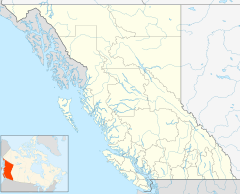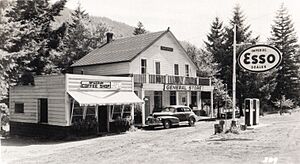Spuzzum facts for kids
Quick facts for kids
Spuzzum
|
|
|---|---|
| Country | Canada |
| Province | British Columbia |
| Region | Fraser Canyon |
| Regional District | Fraser Valley |
| Area codes | 250, 778, 236, & 672 |
| Highways | |
Spuzzum is a small community located in the lower Fraser Canyon area of southwestern British Columbia, Canada. It sits on the west side of the Fraser River and the north side of Spuzzum Creek. You can find Spuzzum on BC Highway 1. It is about 40 kilometers (25 miles) north of Hope and 69 kilometers (43 miles) south of Lytton.
Contents
Spuzzum's First Peoples
First Nations people have lived in the Fraser Canyon for thousands of years. In June 1808, explorer Simon Fraser visited the area. He was seen as a special being by the local people. Fraser noticed blankets made from mountain goat wool and dog hair. He also saw burial boxes placed on tall posts.
At that time, there were two villages called Spuzzum and Schwimp. These were home to the Nlaka'pamux people. Later, they became known together as Spuzzum, which means "little flat." The border between the Upper Sto:lo (Tait) and the Nlaka'pamux peoples was at Sawmill Creek, about 9 kilometers (6 miles) south.
In 1858, the first gold miners came through the area. This led to First Nations and other cultures living together and sometimes marrying. In August 1858, two miners were killed near Spuzzum. In response, about 40 people from Yale traveled north. They fought battles and burned villages.
Historically, First Nations used a large area for their homes, fishing, hunting, and gathering. After 1860, they lost land to new trails, the Cariboo Road, bridges, railways, and settlers. By 1863, most of their land was limited to the south side of Spuzzum Creek. In the 1870s, 149 Indigenous people lived south of the Alexandra suspension bridge. They grew crops like potatoes on about 20 acres of land.
The Spuzzum First Nation is the local Indigenous government. South of the Alexandra bridges, there are several reserves. These include Skuet 6, Papsilqua 2B, Papsilqua 2, Papsilqua 2A, Spuzzum 1, Spuzzum 7, and Spuzzum 1A.
How Spuzzum Got Its Name
In 1848, the Hudson's Bay Company (HBC) built a store called Simon's House. Fur traders would cross the Fraser River there. Ten years later, during the Fraser Canyon Gold Rush, this place was called Spuzzum. Sometimes, it was also called Rancheria.
Spuzzum Mountain, to the northwest, is part of the Coast Mountains.
Spuzzum's Landscape
The Fraser River is narrow and fast-moving at Spuzzum. Gold miners used to work on a large sandbar here. The area is in a tight part of the Fraser Canyon. It is mostly made of strong rock like granite.
South of Spuzzum Creek, the land near the river is low and can get marshy. It often floods in the spring. North of the creek, the land is higher and flatter.
Ferries, Bridges, and Roads
A special ferry, guided by a rope, helped wagons cross the river during the gold rush. This ferry ran on and off from 1848 for about 10 years. Then, it was very busy for five years until the first Alexandra suspension bridge opened in 1863. That bridge was about 4 kilometers (2.5 miles) upstream. The ferry charged 50 cents per passenger. One day, the fare money filled a tin bucket with silver and gold!
In 1858, a private company built a bridge over Spuzzum Creek. They charged a toll to cross it for six months.
In 1862, the government hired Joseph Trutch and Thomas Spence to build a new wagon road. This road went south from the planned Alexandra Bridge to Pike's Riffle. The Royal Engineers helped supervise the work. The road was about 5 meters (17 feet) wide. It was widened to 7 meters (22 feet) in tunnels and cuts. In 1881, a stagecoach fell off a cliff near Spuzzum. Two horses died, and two passengers broke their legs.
During the 1880s, the Canadian Pacific Railway (CP) was built. This construction badly damaged the road between Yale and Spuzzum. But by the early 1900s, people could use this part of the road again. After a big flood in 1894 destroyed the Spuzzum Creek bridge, the 91-meter (300-foot) railway bridge was the only way to cross the creek. A new bridge was built around 1900. It was fixed up again in 1920.
In 1924, W.P. Tierney was hired to rebuild the Yale–Spuzzum road. This work was finished the next year. In 1947, this section of the road was paved.
Between 1956 and 1958, new contracts were given to replace the Spuzzum Creek bridge. This new bridge was west of and higher than the railway bridge. When the new Alexandra Bridge opened in 1962, the main highway went around Spuzzum at a higher level. The second Alexandra Bridge was no longer needed.
In May 2018, Greyhound Canada stopped its bus service to places like Spuzzum. This meant there were no more buses in the area.
Community Life in Spuzzum
During the gold rush, Frank May, who ran the ferry, opened a roadside inn nearby. It was sometimes called California House. It was a large log building. A bishop visiting in 1860 described it as a simple hut. It also had a separate bakehouse that could hold extra travelers.
Most settlers who stayed after the gold rush did not remain much longer. However, more land was claimed by settlers after each new road or railway was built. Mark Francis Andrew claimed land on the west side of the ferry in 1862. By 1866, he was the hotel owner. Magistrate E.H. Sanders, who registered land claims, took the land next to it, south to the creek.
A general store has been in Spuzzum since at least 1890. The post office was open from 1897 to 1975. A school was open from 1897 to 1906.
During World War I, a military camp was built in Spuzzum.
The old two-story general store building opened in the late 1920s. It was on the east side of the railway tracks. A gas station was added later. It sold gas from Gulf, then BA, and finally Esso. This building is now a home. In 1923, a house was built at 38191 Front Street. It had seven bedrooms and was meant to be a hotel when the new highway opened in 1926.
In the 1930s, a police station was set up in the village. By 1941, two police officers lived there. In 1947, the police station moved to Boston Bar.
In the late 1940s, Japanese Canadians who were released from internment camps lived in the hotel building. Jobs became harder to find when the Neville Lumber sawmill closed around 1950. Only three Japanese families stayed in the village. The hotel building is now a home again.
A one-room school operated from 1945 to 1965. It closed with only five students. This building is also now a home.
In 1954, Joyce Gyoba from Spuzzum got the highest score on a scholarship exam. When she earned her nursing degree in 1959, she was recognized as the best student in her class.
In 1958, the general store and gas station moved to a new building on the current highway. The store later closed. In the mid-1970s, the building became the Sasquatch Dining Lounge.
In 1995, a used fire truck was bought for Spuzzum. However, a fire brigade was never formed.
In 1996, the BC Hydro power station in Spuzzum received a big upgrade costing $10.3 million.
The Spuzzum Café was advertised for sale several times in the late 1990s. In 2001, the property burned down. It was the only remaining business in the community, which had only 14 people at the time.
Railways in Spuzzum
In June 1882, the Canadian Pacific Railway (CP) tracks reached Spuzzum from Yale. They continued to a temporary end point at Alexandra Bridge.
In May 1913, the Canadian Northern Railway (CNoR) tracks reached the shore across from Spuzzum.
The Spuzzum train station was built in 1884. It was a single-story building with a pointed roof and windows sticking out. This station was destroyed by a landslide in 1964.
Trains used to stop at Spuzzum. Sometimes it was a regular stop, and sometimes it was a "flag stop." A flag stop means the train only stops if someone waves a flag to get on, or if a passenger on the train asks to get off there.
In 1953, a 445-meter (1,459-foot) railway tunnel was made larger. This allowed bigger loads to pass through.
Notable People
- Carle Hessay (1911–1978), a painter who passed away in Spuzzum.
- George Henry Tomlinson Jr. (1896–1963), a politician who passed away in Spuzzum.
- Annie York (1904–1991), a resident who helped keep First Nations traditions alive.
Images for kids






